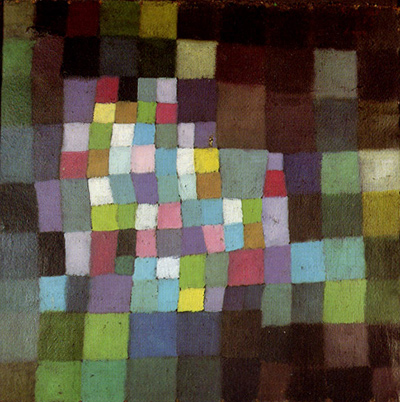Paul Klee is one of the most popular painters of an enduringly popular period.
Klee was a leading figure in the Blaue Reiter movement; along with painters like Franz Marc and Wassily Kandinsky, he was excited by the potential of colour.
Klee saw it as defining him and his art. From his first purely abstract tableau in 1914, he frequently worked with squares and rectangles as his base unit of composition.
However, “Abstraction with Reference to a Flowering Tree” seems anything but static or geometric. Suggesting a rippled or radiating surface that evokes the movement of layered leaf canopy and branches, the surface feels suffused with light.
Although a decade separates them, Abstraction with Reference to a Flowering Tree sheds light on Foehn in Franz Marc’s Garden, painted in 1915 – a beautifully nuanced evocation of dawn or evening light, dark pines and a changeable sky.
This later work is almost wholly abstract. Little of the tree remains except a focal point – the sun illuminating the blossom and leaves from above? – yet the connection to nature, and the response to the experience of natural light and colour, link the two.
However, he was convinced that he could never be understood in his lifetime – even his tombstone declares “I cannot be grasped in the here and now”.
Surely he would be delighted as much as surprised by the way he has entered the language of colour for generations of art lovers, thanks to the reproductions that have popularised and perpetuated his works - the works that he hoped would one day be fully appreciated.
In the “vertigo years” before the First World War, and in the intensity of the decade that followed it, the rediscovery of the power of colour is one of art’s great successes.
Even when accompanied by theory – as in the work of Delaunay and Malevich – it manifests itself with an energy that is palpable a century later: this is why ‘modern’ art begins where it does.




